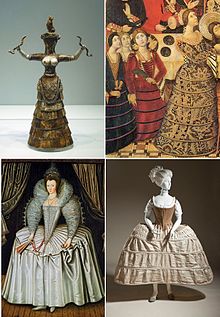– Evolution of Hoop Skirts:
– Hoop skirts were initially worn for practical purposes like staying cool and avoiding tripping.
– They became a fashion statement, evolving into larger sizes in the mid-19th century.
– The introduction of the circular crinoline in 1856 revolutionized women’s fashion.
– The sewing machine mass production of crinolines made them affordable for all classes.
– The fashion trend shifted from bell-shaped skirts to emphasizing volume in the posterior with the crinolette.
– Construction of Hoop Skirts:
– Hoop skirts typically consist of fabric petticoats with channels for stiffening materials.
– Stiffening materials used include rope, osiers, whalebone, steel, and nylon.
– Mid-19th-century crinolines were made of collapsible steel hoops for easy storage and agility.
– Hoop skirts were introduced to the United States in 1846 by David Hough, Jr.
– Hoop skirts have been known by various names in different historical periods.
– Modern Usage of Hoop Skirts:
– Lightweight hoop skirts with nylon hoops are worn under full-skirted wedding gowns.
– Gothic fashion sometimes incorporates hoop skirts.
– Reproduction hoop skirts are essential in living history costuming and Civil War reenactments.
– Hoop skirts have a place in the gothic fashion scene.
– The bustle, a cage at the rear of women’s undergarments, evolved from hoop skirts.
– References:
– Fogg’s “Fashion: The Whole Story” (2013) provides insights into the history of fashion.
– The Smithsonian Institution offers resources on hoop skirts.
– The Victoria and Albert Museum showcases Victorian underwear like corsets, crinolines, and bustles.
– Janet Arnold’s works, such as “Patterns of Fashion,” offer detailed insights into historical clothing construction.
– “Patterns of Fashion 2” by Janet Arnold focuses on English women’s dresses from 1860-1940.
– Sources:
– Janet Arnold’s “Patterns of Fashion” series delves into clothing construction for men and women.
– Arnold’s works have been revised and updated over the years.
– “Queen Elizabeth’s Wardrobe Unlock’d” by Janet Arnold provides historical wardrobe insights.
– Fogg’s “Fashion: The Whole Story” is a comprehensive resource on fashion history.
– True & Co. is a source for fashion-related information.
A hoop skirt or hoopskirt is a women's undergarment worn in various periods to hold the skirt extended into a fashionable shape.

Bottom: Farthingale, c. 1600. Hoop or pannier, 1750–80.

It originated as a modest-sized mechanism for holding long skirts away from one's legs, to stay cooler in hot climates and to keep from tripping on the skirt during various activities. Small hoops might be worn by farmers and while working in the garden. Hoops were then adopted as a fashion item, and the size and scale of the hoops grew in grandeur, especially during the mid-nineteenth century transition from the 1850s to the 1860s. As the society of consumerism evolved, the roles of men and women changed and so did their dress. In the mid-19th century, the fashionable silhouette was a small waist with large, dome-shaped skirts. More and more petticoats were added to make the skirts appear even larger. When the circular crinoline came out in 1856, it was a revelation not only of technology but of convenience for women. The crinoline supported the weight of the numerous skirts and allowed the woman to wear fewer petticoats while still achieving the desired silhouette. The invention of the sewing machine allowed crinolines to be mass-produced at a lower cost, thus making the crinoline available for all classes.
The mania for large bell-shaped skirts phased out through the mid-1860s and slowly shifted to emphasize volume in the posterior. The crinolette came into fashion, which was basically a narrow crinoline with a flat front and cage hoops in the back.
By the 1870s, the cage of the crinolette became a cage only at the rear of the woman's undergarments. This is known today as a bustle.
Hoop skirts typically consist of a fabric petticoat sewn with channels designed to act as casings for stiffening materials, such as rope, osiers, whalebone, steel, or, from the mid-20th century, nylon. The crinoline of the mid-19th century was constructed from collapsible steel hoops. This allowed for easy storage and increased agility for the wearer.
Hoop skirts were first introduced to the United States by David Hough, Jr. in 1846.
Hoop skirts are called by various names in different periods:
- Farthingale (Spanish verdugado) (16th century)
- Panniers or "side hoops" (18th century)
- Crinoline or crinolette (mid-19th century)
Lightweight hoop skirts, usually with nylon hoops, are worn today under very full-skirted wedding gowns. They can sometimes be seen in the gothic fashion scene. Reproduction hoop skirts are an essential part of living history costuming, especially American Civil War reenactment.
